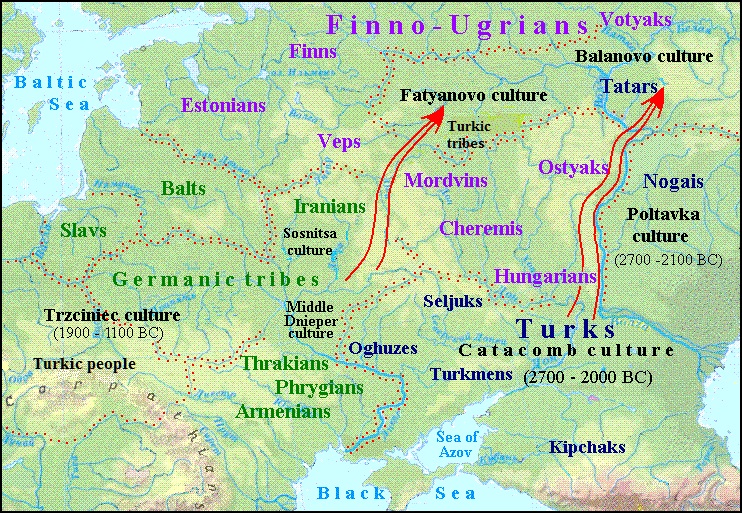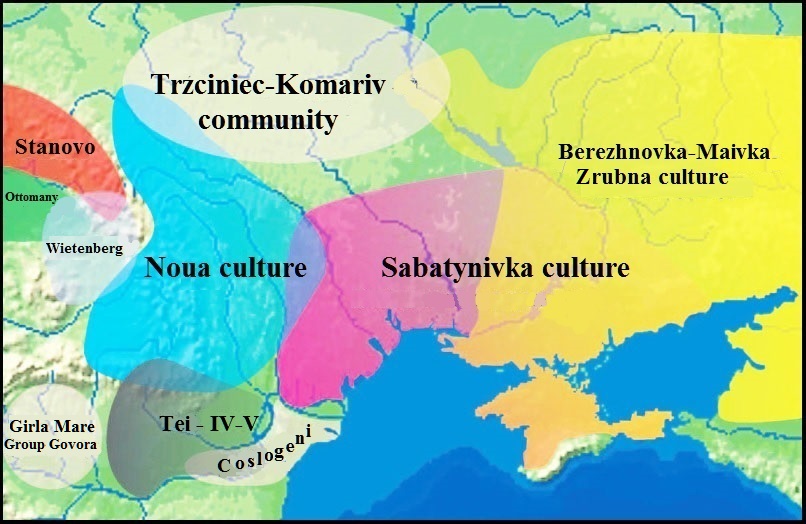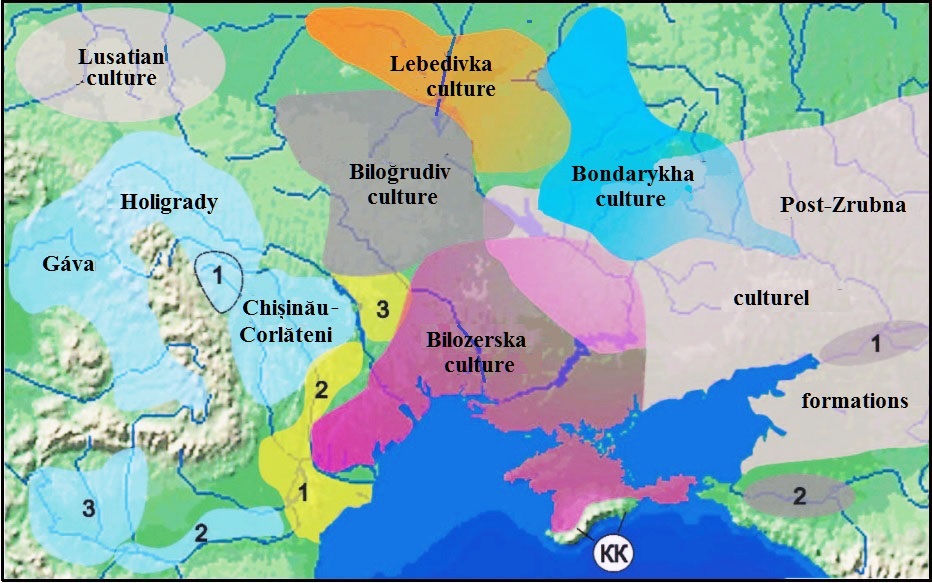Nostratic Languages.
Ethnogenetic Processes in East Europe and Asia till the Bronze Age.
Traces of the first people in Europe are found near the village of Vertessölös in Hungary and in the Italian town of Isernia, which are dated back 850-700 years. BC (DAVIES NORMAN, 2000, 87). A point of view exists that the southern regions of Eastern Europe were first populated by people of Abbevillian culture about 700 thousand years ago, before Mindel Glaciation. This is the area around the Black Sea, where it was warm even in the winter months of the year (Istoriya SSSR, 1966, 18). However, dating sites are found controversial and are not excluded they belong to the next, Acheul period. Relics of Acheulean culture in Ukraine were found in several places along the banks of the Dniester, in particular near the villages of Luka Vrublevetska and Babin (TOLOCHKO P.P., 1994, 14). The data about the Acheulian remains in other parts of Eastern Europe are not available. In what was, at least, two Glaciation and three periods of warming during which the men retreated to the south, then back north again. Anything definite about their role in the ethnogenesis of the modern type of man can be said. In the very warm Mindel-Riss interglacial period, ie approximately 400-200 thousand years ago, a man not only settled south-west Europe (Sites Kasperivtsy, Korman on the Dniester, Peştera Kurate, Ohaba-Ponor Romania, Bojnice in Slovakia, and many others), but also penetrated to the Upper Kama, and "In the early and middle Valdai he dwelt on the Pechora" (GORIETSSKIY G.I., TSEYTLIN S.M.,1977: 17; GUSLITSER B.I., PAVLOV P.Yu.,1987: 21).
During the Mousterian epoch, which began about 80 thousand years ago, Neanderthal man, who did not belong to Homo sapiens sapiens, colonized much of Europe, especially the Eastern one. Settlements of the Mousterian era with artificial dwellings in Ukraine were found on the Dniester near villages Molodovo, Voronovitsa (TOLOCHKO P.P, 1994: 15). In Russia, the most ancient evidence of the Mousterian era was discovered, in particular, near the hamlet Chelyuskinets on the right bank of the Volga, in tracts Zaikino Popelishche and Sukhaya Mechetka in the Volgograd region (TURETSKIY M., 2007: 31-32). In Hungary, the Paleolithic sites of the same epoch were found in caves in the northwest of the country and in Transdanubia (SHUSHARIN V.P., 1971: 10). Then Grimaldi man of Negroid race appeared, but his fate remains unknown. He could have partially or completely assimilated into the later newcomers, been killed by them, or been forced out to other places of settlements.
More detailed here
Left: Ethno-cultural map of Eastern Europe for the period from the 5th to the 3rd millennium BC
Below is an ethnocultural map of Eastern Europe for the period from the end of the 3rd to the end of the 2nd millennium BC
On the basis of the pit culture that existed in the steppes of Ukraine, to the middle of the 3rd millennium BC Corded Ware culture or battle-axes evolved, which carriers, ancient Turkic people soon began a massive settlement on the territory of Eurasia, coming into contact with the indigenous population, which forced to resettlement or assimilated.
Under the influence of local environmental conditions and the ethnic composition of the territories, on the basis of the Corded Ware culture emerged some of its variants, which eventually developed into an independent culture. These are Fatyanovo-Balanovo culture, Middle Dnieper culture, Trzciniec culture, and Komariv culture. The spread territory of the last is not shown on the map, it existed simultaneously with its Trzciniec culture however its carriers were not the Germans but the Proto-Chuvashes.
It should be noted that not all Turkic people left the territory of Europe. Proto-Chuvashes moved westward, and their neighbors, the Tatars chose east. Reaching the Volga, the Tatars did not follow other Turkic tribes who crossed it to the left bank but moved along the right bank northward. Over time, they took the basin of the right tributaries of the Oka and became creators of Fatyanovo culture.
The Turkic people were dismembered by their resettlement the Finno-Ugric territory so that Mordovians, Cheremis, and Magyars remained near their dwelling places, and the rest of the Finno-Ugric tribes moved to the left bank of the Volga in the place of former settlements Samoyeds.
By the end of the Bronze Age, four main archaeological cultures existed on the territory of Eastern Europe: the Trzciniec-Komariv community, the Noua culture, the Sabatynivka culture, and the Berezhnovka-Maivka Zrubna culture. Over time, they were replaced by Belohrudiv, Lebedivka, Bondarykha and other cultures (see maps below).
Northern Black Sea region in the Late Bronze Age.
(according to Yu.A. Chernienko and I.V. Bruyako, ACNW, map 5).
Legend

Early Hallstatt horizon with inscribed pottery. 1 – Sihleanu -Tămăoani-Babadag; 2 – Hansca – Holercani; 3 – Balta group.
Early Hallstatt community of fluted ceramics; 1 – Grănicești; 2 – Montenia sites; 3 – Sites of Oltenia and the Iron Gate district (Vărtop – Hinova -Mala Vrbica).)
The area of Kobyakovo antiquities; 1 – The sites of the Kobyakovo culture; 2 – The sites of the Krasnogvardeyskoye type.
Kizil-Koba culture.





